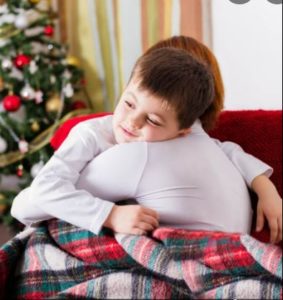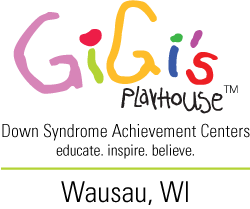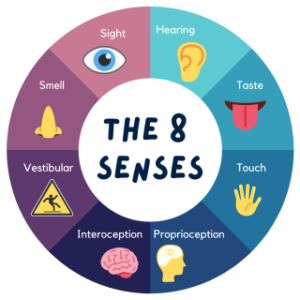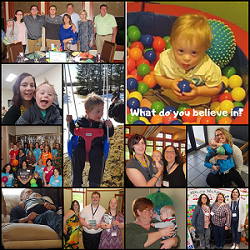Sensory Strategies for the Holidays

The holidays can be an overwhelming time for everyone! From a sensory standpoint, the nervous system has to be able to organize information from all of the sensory systems (there are actually eight sensory systems!) to be able to respond to it appropriately. In general terms, this is called sensory processing, which is how individuals use information from all of the sensory systems to learn about and understand the world around them. The holiday season can be very “sensory overloading,” especially for individuals who may have difficulty taking in and responding to certain sensory input, this is also referred to as sensory modulation dysfunction.
Let’s use a “sensory cup” analogy to help visualize this a bit further. All of our sensory systems can be represented by a normal sized cup. For individuals with intact sensory processing skills, their sensory cups automatically get filled and emptied at a “just right level” throughout the day as sensory information gets processed for optimal learning and functioning. For individuals with sensory modulation dysfunction, specifically sensory over-responsiveness, their sensory cups are too small. This means that just a little bit of sensory information will quickly fill up and overflow the cup. When the cup is overflowing, it is very difficult to empty the cup, and the  individual often responds accordingly (i.e. meltdown, avoidance, fight, flight, or freeze, or other stress responses). During the holidays especially, parents and caregivers have to work hard to problem solve to figure out which sensory cups may be filling up quickly and what strategies may work to keep that cup at the “just right” level.
individual often responds accordingly (i.e. meltdown, avoidance, fight, flight, or freeze, or other stress responses). During the holidays especially, parents and caregivers have to work hard to problem solve to figure out which sensory cups may be filling up quickly and what strategies may work to keep that cup at the “just right” level.
First of all, let’s think about all the sensory information that gets taken in and processed during a typical holiday gathering with family or friends. Visualize each of these systems as a sensory cup that can get overfilled quickly with too much information to take in and process all at once.
- Auditory: lots of people usually means lots of noises! Not only different voices and
 volumes, but also added background noises from music, TV, kitchen appliances, and noisy toys.
volumes, but also added background noises from music, TV, kitchen appliances, and noisy toys. - Visual: a new environment with lots of people means lots of different visual input! Christmas lights, decorations, presents, and moving people/pets usually within a small space.
- Olfactory/Gustatory: new and unusual tastes and smells are typical during holiday gatherings: the scent of the Christmas tree, candles/air fresheners in a family member’s home, and don’t forget the aroma of lots of holiday foods.
- Tactile: new and uncomfortable clothing, family members offering hugs/kisses, other children rough housing or bumping into each other, and touching wrapping paper/presents.
- Proprioception/Vestibular: these are the “movement” sensory systems that are related to body awareness, motor planning, and balance. A holiday gathering may mean either a lot or little proprioceptive/vestibular information depending on the gathering. For example: going sledding or ice skating offers lots of proprioceptive and vestibular stimulation to the nervous system whereas sitting on the couch watching family open presents offers little stimulation.
- Interoception: this is the sensory system that relays information about internal sensations in the body: hunger, thirst, going to the bathroom, or feeling sick. Signals often get mixed or misunderstood when there is a lot of sensory stimulation going on at once.
How can sensory strategies be used to keep these sensory cups from overflowing for successful holiday celebrations with family and friends?
 1. My number one suggestion is to advocate for your child or yourself! Educating family members or friends is a great way to help others learn that sensory overload is a real difficulty within the brain and nervous system and that simple adaptations may help everyone enjoy holiday gatherings more! For example, if you or your child has a small auditory sensory cup, ask kindly if background noises be kept to a minimum (i.e. turning off TV and music or waiting to run the dishwasher until after house guests have left) and allow for increased auditory processing (i.e. speak slowly when having a conversation). Family members may also be able to offer a separate room or quiet space to allow a safe break or calm down space as needed.
1. My number one suggestion is to advocate for your child or yourself! Educating family members or friends is a great way to help others learn that sensory overload is a real difficulty within the brain and nervous system and that simple adaptations may help everyone enjoy holiday gatherings more! For example, if you or your child has a small auditory sensory cup, ask kindly if background noises be kept to a minimum (i.e. turning off TV and music or waiting to run the dishwasher until after house guests have left) and allow for increased auditory processing (i.e. speak slowly when having a conversation). Family members may also be able to offer a separate room or quiet space to allow a safe break or calm down space as needed.
2. Be proactive as much as possible. This is really just an extension of advocating and educating others on you or your child’s sensory needs. By knowing which sensory cups are most likely going to be triggered to overflow at a holiday event, it is helpful to use both accommodations and regulation strategies before, during, and after an event. For example, maybe a calming bath or reading a book ahead of time will help regulate before the event, a weighted blanket, noise cancelling headphones, or a walk outside may help during the event, and soft music may be beneficial post-event.
3. Try to stay on a normal routine as much as possible. One of the best ways to avoid sensory overload is to ensure consistency and predictability in daily routines. Therefore, it is best to try to follow your child’s consistent wake/sleep schedule, mealtime schedule, and bring comfort items or familiar toys with to family gatherings.
4. Try to prepare your child as much as possible leading up to holiday events to allow predictability of what to expect and what activities are scheduled. For some children, simply talking through the day ahead of time, discussing who is going to be there, and when/where the event takes place will be helpful. For other children, using visuals or creating a social story may be beneficial. For example, showing pictures of family members and using a picture schedule or checklist of events will let the child know what to expect.
The magic of the holiday season will hopefully be a little less stressful and overwhelming by remembering to think about and prepare ahead of time for sensory-friendly events!
Alison Vlietstra,
OTR Registered Occupational Therapist
For more information on sensory processing, try looking into these books as resources:
Recent Posts


 volumes, but also added background noises from music, TV, kitchen appliances, and noisy toys.
volumes, but also added background noises from music, TV, kitchen appliances, and noisy toys.

Great information and reminder for all! Thanks for the insight Alison!